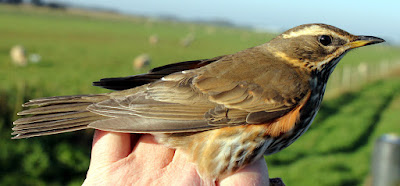This morning saw a heavy and highly visible migration of northern thrushes through our Oakenclough ringing site. Andy, Bryan and I met at 0645 with nets up and set ready for 0715.
We caught very few birds in the less than ideal conditions of a 12/14 mph southerly wind and bright sunshine on one net, but witnessed an impressive movement of Northern thrushes based almost entirely on North West to South East flight lines
Our tally of ringing was just 12 birds - 9 Redwing, 1 Song Thrush, 1 Blackbird, 1 Robin.
Redwing
Song Thrush
These nine birds were a tiny part only of a count from 0800 to 1100 that saw approximately 3800 thrushes - 2300 Fieldfares and 1500 Redwings.
All was quiet until about 0800 when the influx of Redwings and Fieldfares began from the direction of the coast and Morecambe Bay some 15 miles away. It was slow at first, mainly Redwings then as the light and visibility improved we realised that a heavy movement was on the cards. So it began with flocks of anywhere between five, fifty and three hundred thrushes, mostly mixed. There was always a majority Fieldfare configuration, especially in the latter stages when good numbers arrived from a more northerly, even north easterly direction, flying quite low against the now fresh southerly wind.
The plantation has a heavy and very brightly coloured crop of hawthorn and rowan berries that the thrushes targeted as soon as they landed.
Redwing and Fieldfare
Fieldfare
Other birds were in the mix, one or two Song Thrush, Blackbird and Mistle Thrush but almost certainly more in the general melee of hundreds of overhead birds. Otherwise- 25+ Chaffinch, 30 Woodpigeon and one Sparrowhawk that hunted the arriving thrushes.
A further sighting was of three Jays, an essentially sedentary species unless acorn crops fail, when they must migrate to other areas for food. Such years may result in quite large numbers of Jays being seen on visible migration. This may be the case this year with many reports of Jays in unusual and non-regular locations.
Eurasian Jay
In recent days I looked on local Whats App Birding and Bird News, Twitter and Facebook but found no messages, posts or apparent interest in this once in a year spectacle. It would appear that Redwings and Fieldfares are not rare or exciting enough to merit a mention.
The absolute best local web and information site I know belongs to Bryan Yorke, who come rain or shine, conducts daily visible migration counts at Burton in Kendal, Arnsideand Silverdale Blog , some 20 miles just north west of Okenclough. His sightings and counts give a useful comparison to our own. Bryan's very low counts from today seem to point to this morning’s thrushes taking both more coastal and also inland Pennine routes.
"Wednesday 23rd October 2019
Taylors Fields, Vicarage Lane, Burton In Kendal 0730hrs"
"Obviously the thrushes were not about other than a sprinkling which seemed to be going in various directions."
Linnet: 216 (213 SE and 3 SW)
Redpoll: 3 SE (one party)
Greenfinch: 1 SE
Alba Wagtail: 11 SE
Skylark: 6 SE
Fieldfare: 98 (20 W/SW,10E,4E,4E,6NW,9W,30SW,15N)
Redwing: 171 (5SW,3SW,30SW,12SW,50SE,1E,6E,30SW,10SW,9S/SW,5SW,10SW)
Starling: 50W (15,2,4,5,20,4)
Woodpigeon: 29 NW
Pink Footed Goose: 6 SE at 1135hrs"
Back soon folks. Keep logging in for more news, views and photos.
Linking this post to Anni's Birding Blog.















































































